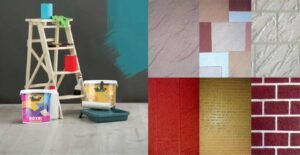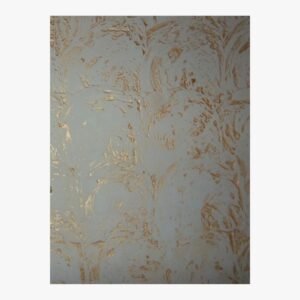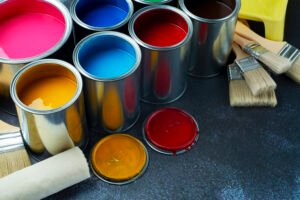Introduction to Paints and Textures
Best Paints and Textures for Your Home
Choosing the right paint and texture for your home is a crucial aspect of any home improvement project. The right combination of paint colors and textures can dramatically alter the ambiance of a space, transforming it into a more aesthetically pleasing and comfortable environment. A carefully chosen palette has the power to enhance the visual appeal of your interiors, while certain textures can add depth and dimension, turning a bland room into a dynamic and engaging space.
Understanding the impact of paint and texture extends beyond mere aesthetics. Colors can evoke particular emotions and affect mood, making it essential to select shades that align with the intended purpose of each room. For example, cool tones might foster a calm and relaxing atmosphere, whereas warm hues can energize and stimulate a space. On the other hand, different textures can influence the tactile experience and visual perception of the room, playing a significant role in the overall comfort and livability of your home.
This comprehensive guide will walk you through the various options available in paints and textures, providing insights into how to make the best choices for your specific needs. From understanding the different types of paints available, such as latex and oil-based, to exploring a range of textures from smooth finishes to intricate patterns, we cover it all. Our aim is to equip you with the knowledge to make informed decisions that can bring your vision to life while maintaining functionality and aesthetics.
Readers can expect to gain a thorough understanding of how to select the ideal paint and texture combinations, tips for application, and expert recommendations for various spaces within the home. Whether you’re embarking on a major renovation or simply seeking to refresh a single room, this guide will serve as your go-to resource for achieving professional-grade results.

Types of Paints: Exploring Options
When selecting the appropriate paint for your home, understanding the diverse types available can significantly impact the outcome of your project. Each type of paint has distinct characteristics, benefits, and ideal applications. Here, we will delve into latex, oil-based, acrylic, and watercolor paints to help you make an informed decision.
Latex Paint
Latex paint, also known as water-based paint, is a popular choice for its ease of use and quick drying time. It is celebrated for being environmentally friendly, emitting low levels of volatile organic compounds (VOCs). One of its primary advantages is its flexibility and resistance to cracking, making it perfect for walls and ceilings. However, latex paint may not adhere well to high-gloss surfaces like trim or cabinets without proper preparation.
Oil-Based Paint
Oil-based paint is renowned for its durability and smooth finish. It is ideal for high-traffic areas, trim, and cabinetry, providing a hard, washable surface. The downside is its longer drying time and stronger odor, along with higher VOC emissions. Cleaning up oil-based paint requires mineral spirits or solvents, adding to its maintenance duties.

Acrylic Paint
Acrylic paint offers a versatile middle ground, combining qualities of both latex and oil-based paints. It provides excellent adhesion to various surfaces, including wood, metal, and masonry. Acrylic paint is resistant to fading, making it suitable for both indoor and outdoor applications. One limitation is that it can sometimes be less smooth compared to oil-based paints but makes up for it in ease of cleanup with water.

Watercolor Paint
Watercolor paints are known primarily for artistic applications rather than home interior painting. They offer a transparent, light finish and are predominantly used for decorative purposes, like mural painting or accent art within the home. While they provide stunning visual effects, they are not suited for surfaces that require durability or moisture resistance.

| Type of Paint | Characteristics | Pros | Cons | Suitable Applications |
|---|---|---|---|---|
| Latex | Water-based, flexible | Quick drying, easy cleanup, low VOCs | Less durable on high-gloss surfaces | Walls, ceilings |
| Oil-Based | Durable, smooth finish | Hard, washable, long-lasting | Strong odor, high VOCs | Trim, cabinets, high-traffic areas |
| Acrylic | Versatile, good adhesion | Fade-resistant, easy cleanup | Can be less smooth | Wood, metal, masonry |
| Watercolor | Transparent, light finish | Artistic effects | Not durable, moisture-sensitive | Decorative murals, accents |
Popular Paint Finishes and Their Uses
Choosing the right paint finish is essential for achieving the desired aesthetic and functionality in your home. Each finish affects the appearance and durability of painted surfaces differently. Let’s take a closer look at some popular paint finishes and their optimal uses.
The matte finish, also known as flat finish, provides a non-reflective, smooth appearance. It is excellent for concealing surface imperfections such as cracks and bumps. Due to its low durability, it’s best suited for areas with minimal foot traffic and low exposure to dirt and grime, such as ceilings and adult bedrooms.
Eggshell finish offers a subtle sheen, sitting between matte and satin on the gloss spectrum. It is slightly more durable than matte, making it suitable for living rooms, dining areas, and hallways, where a bit of wear and tear can be expected. Eggshell finishes are easier to clean than matte, but still not ideal for high-traffic areas.
Satin finish presents a soft sheen and is significantly more durable than both matte and eggshell finishes. It strikes a balance between aesthetics and practicality, making it a popular choice for family rooms, kitchens, and bathrooms. It withstands moderate scrubbing and cleaning, making it a versatile option for areas that see moderate use.
Semi-gloss finish provides a noticeable shine and is highly durable. It is resistant to moisture and stains, making it perfect for high-traffic areas and rooms exposed to high humidity levels, such as bathrooms, kitchens, and children’s rooms. Its robust surface allows for frequent cleaning, ensuring longevity and a polished look.
High-gloss finish offers the most reflective surface of all the finishes. It’s exceedingly durable and easy to clean, making it ideal for areas requiring frequent maintenance, such as doors, trim, and cabinets. Its highly reflective nature, however, highlights surface imperfections, so it’s best used on smooth, well-prepared surfaces.
By understanding the properties and best uses for different paint finishes, you can make informed decisions for each area of your home, ensuring both beauty and longevity in your painted surfaces.
The Science of Colors: Choosing the Perfect Palette
The journey to selecting the perfect palette for your home begins with mastering the fundamentals of color theory. Understanding the color wheel, primary and secondary colors, and their combinations can greatly influence your interior design choices. The interplay of hues, shades, and tints defines the ambiance of any given space.
The psychological effects of colors significantly impact how we perceive and interact with our environment. For instance, warm tones like reds, oranges, and yellows tend to evoke feelings of energy and warmth, fostering a cozy atmosphere. In contrast, cooler tones such as blues, greens, and purples often bring a sense of calm and tranquility, making them ideal for spaces designed for relaxation and reflection.
When selecting a color scheme, it is crucial to consider how these hues complement your home’s architecture and furnishings. Neutral colors like whites, beiges, and grays provide a versatile foundation, allowing more vibrant accents to shine without overwhelming the space. Additionally, incorporating complementary colors—opposites on the color wheel—can create balanced and visually appealing contrasts. Analogous color schemes, utilizing neighboring hues, foster unity and a harmonious flow.
A practical approach to defining your palette involves creating mood boards. These visual tools amalgamate paint samples, fabric swatches, and other decorative elements, offering a tangible preview of how various combinations work in tandem. Using online design platforms or physical boards, you can experiment with different ideas until you discover a scheme that resonates with your vision.
Before committing to a full-scale application, testing color samples is imperative. Paint small sections of your walls or use sample boards to observe how each color reacts under various lighting conditions throughout the day. This step ensures that you make informed decisions and avoid costly mistakes. Remember, lighting can dramatically alter the perception of color, and what looks appealing in natural daylight might diverge significantly under artificial light.
Ultimately, the science of colors and their thoughtful application in interior design not only enhances the aesthetic appeal but also transforms your home into a sanctuary that reflects your personality and lifestyle.

Texture Techniques: Adding Depth and Dimension
Adding texture to your walls can transform a plain space into a visually engaging environment. Several techniques and products can help you achieve the desired effect, ranging from simple to intricate designs. Below, we delve into some popular methods like sponging, rag rolling, stippling, and combing, as well as textured paint products such as Venetian plaster and sand paint. These approaches can provide your walls with a unique character, making any room in your home feel more dynamic and stylish.
Sponging: Sponging is one of the simplest texture techniques, perfect for beginners. Start by selecting a base color for your wall and applying the paint evenly. Once the base coat is dry, dip a natural sea sponge into a lighter or contrasting paint color and gently dab it onto the wall. This technique adds a soft, mottled effect, ideal for creating depth.
Rag Rolling: Rag rolling offers a bold texture effect and requires a soft cloth or rag. After applying a base coat, roll the rag into a tube shape, dip it into your chosen paint, and then roll it over the wall’s surface. This method produces a unique, marbled finish that adds sophisticated textures to your walls.
Stippling: For those seeking a refined texture, stippling is an excellent choice. Using a stippling brush or sponge, dab paint onto the wall in a controlled, repeated motion. The result is a delicate, textured surface that can variably alter the appearance of light and shadow in a room.
Combing: Combing is perfect for a linear, striped effect. Begin with a base coat, and once it’s dry, apply a glaze layer. While the glaze is wet, use a combing tool or a rubber comb to drag through the paint, creating straight or wavy lines. Combing can add an elegant and organized texture to your walls.
Venetian Plaster: Venetian plaster is a versatile product that can create a high-end, polished look. It involves applying several layers of plaster with a trowel and then burnishing the surface to achieve a smooth or glossy finish. Although this technique requires some skill, the luxurious texture it provides can significantly enhance a room’s ambiance.
Sand Paint: Sand paint is ideal if you’re looking for grainy, rustic textures. It contains sand particles that add a gritty texture to your walls. Simply paint your wall as usual, ensuring the sand paint is thoroughly mixed, and you’ll end up with a robust, textured surface that hides imperfections well.
With an array of texturing techniques to choose from, homeowners can experiment and discover the perfect fit for their aesthetic preferences. Whether you’re a novice looking for a simple sponging project or a seasoned DIY enthusiast eager to tackle Venetian plaster, these methods can refresh and personalize your home’s interior beautifully.

Best Paint Brands and Products on the Market
When it comes to selecting the best paints and textures for your home, choosing a reputable brand is essential. Among the top contenders are Sherwin-Williams, Benjamin Moore, Behr, and Valspar, each offering a range of high-quality products tailored to various needs and preferences.
Sherwin-Williams is renowned for its premium quality paints, with the Emerald line standing out for its durability and washability. The brand’s commitment to innovation includes its Harmony line, which is low-VOC and reduces indoor air pollution, making it a top choice for eco-conscious homeowners. Sherwin-Williams consistently receives high marks from customers and frequent accolades from the paint industry.
Benjamin Moore’s Regal Select is another flagship product highly praised for its rich colors and excellent coverage. Known for its dedication to sustainability, Benjamin Moore offers the Natura line, virtually odorless and zero-VOC, providing a healthier alternative without compromising quality. Expert opinions often highlight the brand’s custom color matching and consistency, ensuring a flawless finish.
Behr has established itself as a reliable and affordable option, with products like the Marquee line providing advanced stain-blocking technology and superior durability. Behr’s Premium Plus Enamel is notable for its low-VOC formulation, appealing to those prioritizing environmental impact. Customer reviews frequently commend Behr for its value, accessibility, and ease of application.
Valspar, a brand synonymous with innovation, offers the Reserve line known for its exceptional stain resistance and vivid color retention. The Simplicity line is a low-VOC option designed for safer, cleaner air quality. In the paint community, Valspar is often recognized for its broad color palette and versatile applications, making it a favorite among DIY enthusiasts and professionals alike.
Each of these brands brings unique strengths to the table, whether through environmental initiatives, durability, or color selection. A careful consideration of these top paint brands and their flagship products can ensure you achieve the desired aesthetics and functionality for your home.

Tips and Tricks for a Flawless Paint Job
Achieving a professional-quality paint job involves more than just picking out the right color. Proper preparation, the right tools, and keen attention to detail can significantly elevate the outcome. The first step to a flawless paint job is preparing the surface. Clean the walls thoroughly to remove dust, grease, and stains. This ensures that the paint adheres well and provides a smooth finish. Any existing imperfections, like holes or cracks, should be filled and smoothed out with sandpaper.
Priming the walls is equally important. A good primer not only provides a uniform base but also enhances the durability and vibrancy of your paint. It’s especially crucial when switching from a dark to a lighter shade or painting over new drywall. Choosing the appropriate primer according to your surface type can make a substantial difference in the final appearance.
Investing in quality brushes and rollers is another key aspect. Opt for high-quality synthetic-bristle brushes for latex paints and natural-bristle brushes for oil-based paints. For larger areas, a good roller with the appropriate nap length can efficiently cover surfaces with minimal effort. Ensure that the roller is evenly coated with paint and use a zigzag or “W” pattern to spread the paint uniformly, avoiding streaks.
Being mindful of common painting mistakes can save both time and frustration. For instance, overloading the brush or roller can lead to drips and uneven application. Conversely, using too little paint results in poor coverage and thin spots. Maintain a wet edge by blending each stroke into the previously applied paint to prevent lap marks.
If you encounter issues like streaks, drips, or uneven coverage, there are troubleshooting tips to consider. For streaks, lightly sand the affected area and apply another coat of paint. Drips can be reduced by applying thinner layers and allowing sufficient drying time between coats. For uneven coverage, additional coats may be necessary, ensuring that each layer is thoroughly dry before adding the next.
In conclusion, a flawless paint job is achievable with meticulous preparation, the right tools, and attention to technique. These tips and tricks will help ensure your home’s new paints and textures bring a refreshed and professional appearance to your spaces.
Maintaining Your Painted and Textured Walls
Upon completing the decoration of your home with the best paints and textures, maintaining the pristine condition of these surfaces becomes imperative. The first step in caring for painted and textured walls involves regular and proper cleaning. For walls painted with satin or semi-gloss finishes, which are commonly used in high-traffic areas, a simple solution of mild detergent mixed with water can be effective. Wipe down the surfaces with a soft cloth or sponge, ensuring you avoid abrasive materials that may scratch or damage the paint.
Flat or matte finishes, which tend to show marks and stains more easily, require a gentler approach. A damp microfiber cloth, gently dabbed onto the affected area, often suffices for removing smudges without affecting the paint. For stubborn stains, consider a specialized cleaner designed for flat finishes. Textured walls, on the other hand, necessitate a bit more care. Dusting regularly with a microfiber duster or a vacuum cleaner with a soft brush attachment can help maintain texture integrity and cleanliness.
Minor repairs are inevitable over time, no matter the paint quality or finish. Small dents or holes can be addressed using spackle or lightweight putty. Once the filler is dry, it should be sanded smoothly to blend seamlessly with the surrounding area. Touching up with leftover paint from your initial project ensures color consistency. However, if the damage is extensive or repeated touch-ups create inconsistencies, it might be wise to consider a repaint for a uniform appearance.
Identifying when it’s time for a full repaint depends on various factors. These include visible signs of wear and tear, persistent stains that cannot be cleaned, paint peeling, or fading due to sunlight exposure. Regular maintenance, combined with these repair insights, can prolong the lifespan of your painted and textured walls, keeping them attractive and ensuring your home remains a vibrant and welcoming space.


